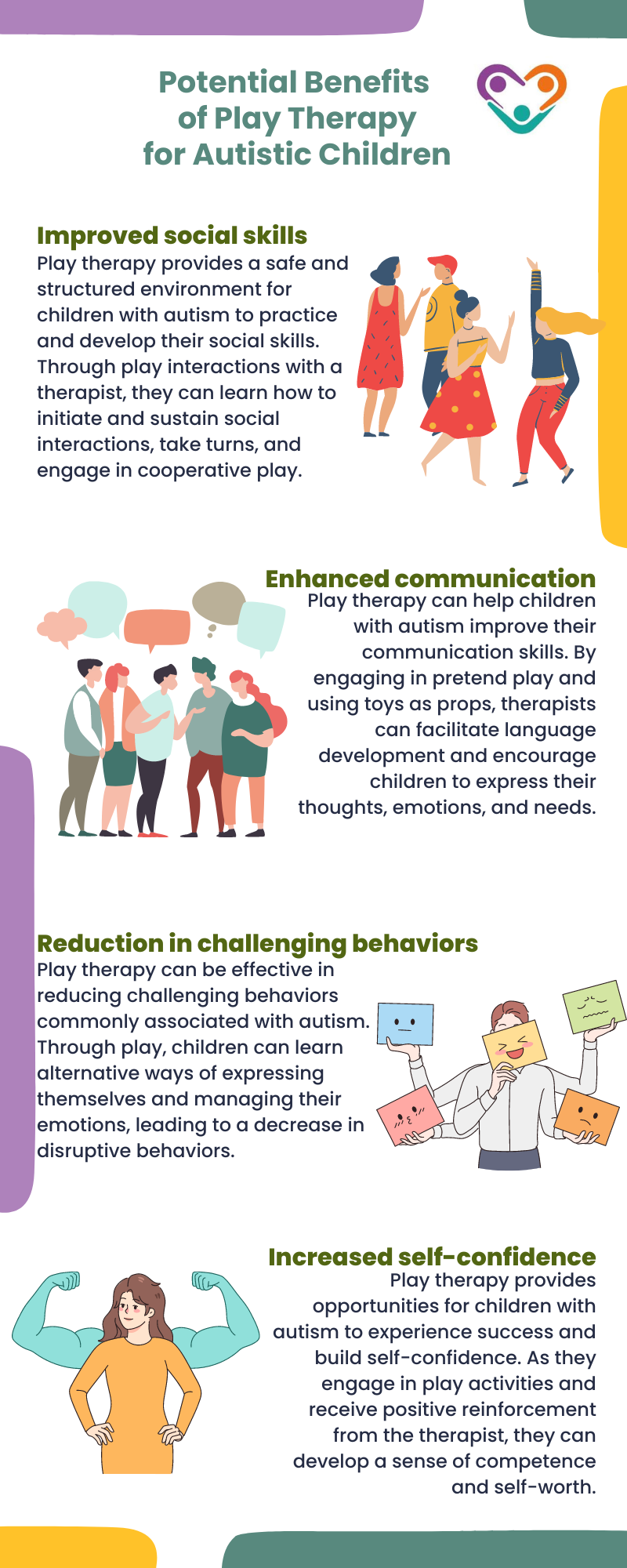
Table of Contents
Play therapy is a therapeutic approach that utilizes play as a means of communication and expression for individuals with autism. This method recognizes the importance of play in a child’s development and leverages it to address specific needs and challenges associated with autism.
By engaging in play-based activities, children with autism can explore their feelings, environment, and relationships with others, allowing for shared interactions and growth.
Play Therapy Techniques
Play therapists employ various techniques to engage individuals with autism in meaningful play experiences. These techniques are tailored to meet the unique needs and goals of each individual.
Here are some common play therapy techniques used on autistic individuals:
- Floortime Approach – The Floortime approach focuses on following the child’s lead and joining them in their preferred activities. Therapists actively participate in the child’s play, engaging in back-and-forth interactions and encouraging the child’s communication and problem-solving skills.
- The Play Project – The Play Project is a play-based intervention that emphasizes building reciprocal skills, imaginative skills, and abstract thinking skills. Therapists utilize play activities to help children relate to others, develop social skills, and involve parents or guardians in the therapy process.
These play therapy techniques create a supportive environment where individuals with autism can engage in purposeful play, leading to positive outcomes in their physical, cognitive, emotional, and social development.
Implementing Play Therapy for Autism
Play-based approaches have shown great promise in promoting social interaction, communication, and overall development among autistic individuals.
That said, implementing play therapy for autism involves two things, namely:
Play Therapy Approaches
There are various play therapy approaches that have been found to be effective for individuals with autism. Two notable examples are the Floortime approach and The Play Project. These play-based techniques aim to help autistic children become more fully themselves, enhance their connection with parents and guardians, and develop important skills such as communication and social interactions.
The Floortime approach emphasizes engaging children in play that follows their lead. The focus is on building reciprocal skills, imaginative abilities, and abstract thinking skills. Through this approach, children are encouraged to relate to others, develop social skills, and foster relationships in a safe and supportive environment.
The Play Project is another play therapy approach that involves play therapists working closely with autistic children and their families. The goal is to help children develop skills in areas such as communication, social interaction, and emotional regulation. This approach places particular emphasis on involving parents or guardians in the therapy process, empowering them to play an active role in their child’s development.
Role of Play Therapists
Play therapists play a vital role in the implementation of play therapy for autism. These professionals possess specialized training and expertise in using play-based interventions to support children with autism. They create a nurturing and structured environment that encourages children to explore, engage, and learn through play.
Play therapists focus on tailoring the therapy to meet the unique needs of each child. They employ various techniques and strategies to facilitate social interaction, communication, and emotional growth.
By observing and interacting with the child during play sessions, they can identify areas that require attention and develop individualized interventions.
In addition to working directly with the child, play therapists also involve parents or guardians in the therapy process. They provide guidance, support, and education to help parents understand their child’s needs and learn ways to incorporate play therapy techniques into daily routines. Collaborating with parents or guardians ensures continuity of care and maximizes the benefits of play therapy for the child.
Implementing play therapy for autism can be done through various avenues, such as local early intervention programs, specialized preschool programs, or certified Floortime specialists.
Families can also seek play therapy services through occupational therapists, child psychologists specializing in autism, or group programs offered by autism clinics, hospitals, or private service providers. It is important to consult with professionals experienced in play therapy to determine the most suitable approach for the child’s unique needs.
Effectiveness of Play Therapy
While research in this area is still limited, early studies suggest that play therapy can have positive effects on children with autism, particularly in improving social behaviors and play interactions.
Currently, only a small number of studies have been published on the use of play therapy specifically for children with ASD. These studies have primarily focused on child-centered play therapy, which aims to enhance social engagement and play interactions. Participants in these studies ranged from five to 11 years old.
Despite the limited research, these studies have shown promising results. All five studies reported a small increase in social engagement and play interactions among the participants.
However, it’s important to note that more extensive research is needed to draw definitive conclusions about the effectiveness of play therapy for children with autism.
Researchers recognize the need for better-designed studies with larger participant groups, play therapy as the sole intervention, and stronger experimental designs. These factors are crucial for confidently determining whether behavior change can be attributed to play therapy.
Potential Benefits for Children
While further research is required to establish the exact effectiveness of play therapy for children with autism, anecdotal evidence and early studies suggest potential benefits. Play therapy can offer a range of advantages, including:
It’s important to note that the effectiveness of play therapy may vary from child to child. Each child with autism is unique, and the success of play therapy as an intervention depends on various factors, including the individual’s specific needs, preferences, and level of engagement.
As research in this area continues to evolve, it is hoped that a clearer understanding of the effectiveness of play therapy for children with autism will emerge. In the meantime, parents and caregivers may consider exploring play therapy as a potential intervention, alongside other evidence-based approaches, to support the overall development and well-being of children with autism.
We, at Behavioral Intervention, offers a comprehensive ABA therapy in Florida. Our dedicated team provides tailored interventions to address specific challenges and improve overall well-being.
Interested in how our services can make a difference for you or your team? Reach out to us today to explore how we can help.
Sources:
https://www.verywellhealth.com/play-therapy-and-autism-the-basics-260059
https://www.appliedbehavioranalysisedu.org/how-is-play-therapy-used-to-treat-autism
- 9 Common Obsessions of Children With Autism You Should Know - February 25, 2025
- What is Neurodiversity? A Guide to Embracing Differences - February 25, 2025
- Understanding Hyperfocus in Autism: What It Means and Why It Happens - February 25, 2025




